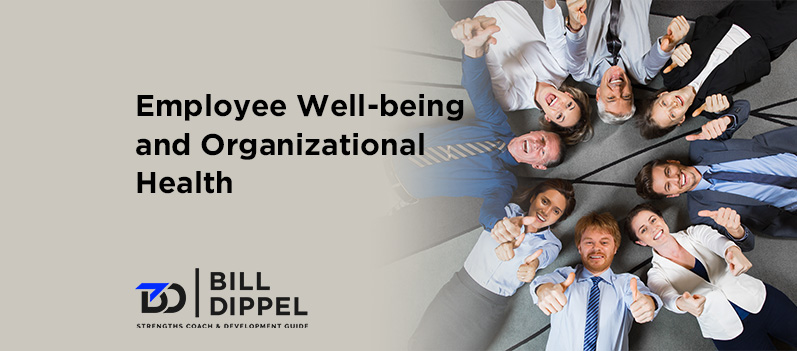Take Control of Employee Well-being and Help Your Organization Thrive
Maintaining employee well-being is vital to keeping your company thriving and productive. Protecting your most valuable resource shouldn’t be left to chance. Often, companies treat employee well-being ineffectively by waiting until the need for corrective action or, worse, when people start leaving. As with most problems, the best way to handle them is before they become a problem.
Regardless of whether you’re facing a crisis or sailing smoothly, you need a plan to maintain or improve employee well-being. Luckily, there are scientifically backed methods to keeping employees happy and productive, and you could start using them as early as today.
“Your work culture is something you can control with the right approach, and employees who feel good do better work and are more productive”
What is Employee Well-being?
As a Gallup Certified Strengths Coach, I use a proven system to help leaders and businesses understand their strengths and weaknesses in concrete, actionable ways. In the area of employee well-being, Gallup has discovered five core elements that we use to evaluate well-being:
- Career
- Social
- Financial
- Physical
- Community
Each core pillar can be used to evaluate a different facet of a person’s experience. So, when I say that employee well-being is complicated, what I mean is people are complex. The same approach isn’t going to work for everyone. Someone might be completely satisfied with their financial well-being and be utterly dismayed by their community well-being. The inverse could be true for another employee and every permutation you can think of. The problem isn’t one-size-fits-all, so your approach shouldn’t be either!
 Why Does Employee Well-being Matter?
Why Does Employee Well-being Matter?
The simple answer is that employees who feel good do better work and are more productive. The longer answer dives into current Gallup research to understand what’s actually happening to people in the workforce. A seemingly positive statistic is that 33% of the workforce is thriving because they feel fulfilled in their work. What that statistic says to me, however, is that more than half of employees are not thriving. In fact, 55% are struggling, and a dismaying 11% are suffering.
The people who aren’t thriving are experiencing stress, worry, sadness, and anger. As an employer, these negative outlooks translate to less productive employees.
The most common thing I hear as the solution to secure employee well-being is that people need to manage their work-life balance better. Firstly, this puts the burden completely on the shoulder’s of the employee. Secondly, this balance is often allegedly achieved by reducing the time spent doing work. While this is effective for some, Gallup found that how people feel about their work has a more substantial impact than the amount of work done. The quality of an employee’s work is up to three times more important to their well-being than time spent.
The pandemic also drastically changed employees’ expectations of their employers. Employee belief that their employer cared about their well-being spiked with the pandemic as many companies stepped up and did their part to keep people safe and secure. Now that things are returning to “normal,” this metric has dropped below the level before the pandemic. In short, employees expect more from their employers now, and many aren’t meeting those expectations. If these concerns aren’t addressed, companies can expect decreased productivity and higher turnover.
 How Do We Meet Employee Well-being Expectations?
How Do We Meet Employee Well-being Expectations?
Work and life are not mutually exclusive. The idea that a work-life balance must be established isn’t quite right. What really needs to be understood is that work is a part of life. Feeling fulfilled in work is vital to feeling fulfilled as a whole. Here are a few places to start when addressing employee well-being:
Put Well-being into Focus
The first step to securing positive employee well-being is to measure it. If you don’t know what the problem areas in your organization are, you might do more harm than good if you try to help. Shoring up the company fridge with healthy snacks while employees are experiencing burnout could backfire and be perceived as a way to keep employees in the office longer.
Integrate Well-being into Your Work Culture
Once you understand the broader picture of your organization, you can tackle the necessary steps to establish positive employee wellness. Your work culture is something you can control with the right approach. Gallup metrics and CliftonStrengths can be two valuable tools to that end. Here are some examples of ways to accomplish this goal:
- Use strengths-based training and approaches in all aspects of employee engagement. It has been shown that a strengths-based approach helps employees evaluate themselves and their peers in ways that maximize productivity and positivity.
- Remove obstacles to productivity. Often these obstacles are organizational hurdles or simply due to poor management. Correct these, and well-being will increase dramatically.
- Change manager mentality. Managers should be trained to become coaches. The ability to create and achieve strategic goals is directly linked to their ability to understand the people they’re managing.
You will know you’ve succeeded when you can say that the following are true of your organization:
- Each employee feels they are helping each other achieve their goals every day
- Employees receive adequate coaching from their managers to perform and improve
- Employees believe their managers and leaders care about their well-being
- Employees naturally and willingly engage in a positive work culture
Closing Thoughts
The best way to approach employee well-being is with compassion. Understanding what makes your people different and what they need to succeed and grow will be much more beneficial than guessing and hoping. Get concrete data to understand your organization’s needs, and then take corrective action that works. What’s suitable for your employees will be good for the organization. Put in the work to understand your employees’ current well-being, and the results will speak for themselves.
Start understanding your employee well-being by working with us to assess your organization’s strengths and weaknesses. We will work with you to craft a plan to address your employees’ specific needs.
- Schedule A Call. Set up a complimentary 15-minute call. We’ll discuss leveraging CliftonStrengths and Gallup metrics to maximize employee well-being.
- Get A Plan. We will help you craft a customized plan to address your organization’s strengths and weaknesses.
- Carry It Forward. Help your employees take the skills you’ve given them and keep the positive momentum.


Recent Comments